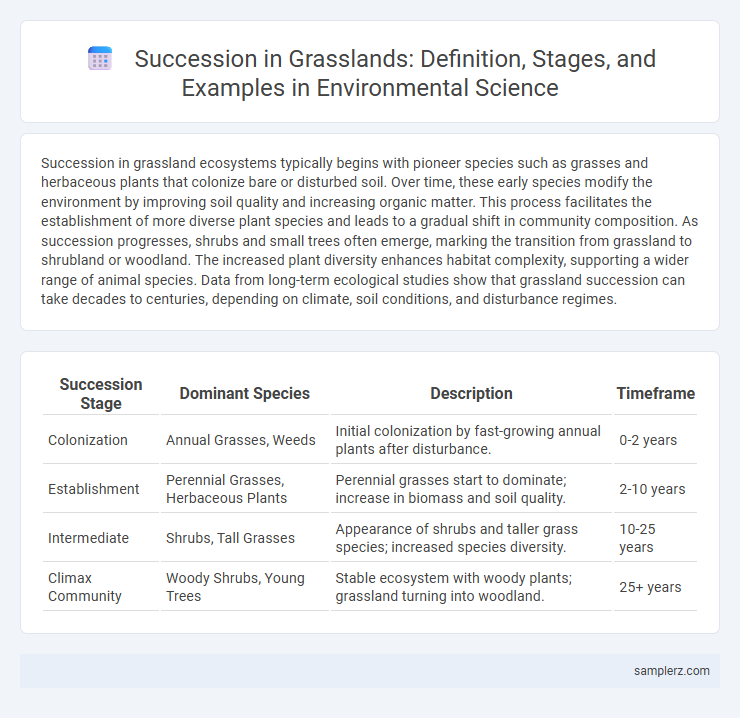Succession in grassland ecosystems typically begins with pioneer species such as grasses and herbaceous plants that colonize bare or disturbed soil. Over time, these early species modify the environment by improving soil quality and increasing organic matter. This process facilitates the establishment of more diverse plant species and leads to a gradual shift in community composition. As succession progresses, shrubs and small trees often emerge, marking the transition from grassland to shrubland or woodland. The increased plant diversity enhances habitat complexity, supporting a wider range of animal species. Data from long-term ecological studies show that grassland succession can take decades to centuries, depending on climate, soil conditions, and disturbance regimes.
Table of Comparison
| Succession Stage | Dominant Species | Description | Timeframe |
|---|---|---|---|
| Colonization | Annual Grasses, Weeds | Initial colonization by fast-growing annual plants after disturbance. | 0-2 years |
| Establishment | Perennial Grasses, Herbaceous Plants | Perennial grasses start to dominate; increase in biomass and soil quality. | 2-10 years |
| Intermediate | Shrubs, Tall Grasses | Appearance of shrubs and taller grass species; increased species diversity. | 10-25 years |
| Climax Community | Woody Shrubs, Young Trees | Stable ecosystem with woody plants; grassland turning into woodland. | 25+ years |
Introduction to Ecological Succession in Grasslands
Grassland ecological succession typically begins with pioneer species such as grasses and herbaceous plants that stabilize the soil and create conditions favorable for subsequent species. Over time, shrubs and small trees gradually establish, leading to increased biodiversity and a shift towards a more complex ecosystem. This natural progression enhances soil fertility and supports a wider range of wildlife, promoting ecosystem resilience in grassland environments.
Stages of Grassland Succession
Early stages of grassland succession typically involve the colonization of pioneer species such as grasses and herbaceous plants, which stabilize the soil and increase organic matter. Mid-successional stages see the introduction of shrubs and perennial grasses, enhancing biodiversity and improving nutrient cycling. In climax stages, a mature grassland ecosystem develops with a complex structure of diverse plant species, supporting a wide range of fauna and maintaining ecological balance.
Primary Succession in Grassland Ecosystems
Primary succession in grassland ecosystems begins on bare soil or rock where no previous vegetation existed, such as after a glacier retreat or volcanic eruption. Pioneer species like lichens and mosses colonize the area, gradually breaking down substrate to form soil, enabling grasses and herbaceous plants to establish. Over time, this process leads to increased biodiversity and the development of a stable grassland biome.
Secondary Succession after Disturbance
Secondary succession in grasslands occurs after disturbances such as wildfires, grazing, or agricultural activities, where soil remains intact but vegetation is temporarily removed. Pioneer species like grasses and herbaceous plants rapidly colonize the area, stabilizing the soil and creating conditions favorable for shrubs and woody plants to establish over time. This gradual process restores biodiversity and ecosystem functions, eventually returning the grassland to a mature and stable state.
Role of Fire in Grassland Succession
Fire plays a crucial role in grassland succession by removing accumulated dead plant material, which stimulates new growth and maintains species diversity. Periodic fires prevent the encroachment of woody plants and promote the dominance of fire-adapted grasses such as bluestem and buffalo grass. This natural disturbance regulates nutrient cycling and supports a dynamic equilibrium essential to sustaining healthy grassland ecosystems.
Pioneer Species in Grassland Recovery
Pioneer species in grassland recovery, such as blue-green algae and lichens, initiate soil stabilization by fixing nitrogen and enhancing soil fertility. These hardy organisms create favorable conditions for secondary colonizers like grasses and herbaceous plants to establish. This successional process gradually transforms barren or disturbed land into a thriving grassland ecosystem with increased biodiversity.
Impact of Grazing on Succession Patterns
Grazing significantly influences succession patterns in grasslands by altering species composition and soil properties. Selective feeding by herbivores can suppress dominant grasses, allowing less competitive or invasive species to establish and modify community structure. This disturbance accelerates or redirects successional stages, impacting biodiversity and ecosystem resilience.
Invasive Species and Successional Change
In grassland ecosystems, invasive species such as cheatgrass (Bromus tectorum) can disrupt natural successional processes by outcompeting native grasses and altering soil chemistry. This shift in plant composition accelerates the transition from native perennial grasslands to invasive-dominated landscapes, reducing biodiversity and ecosystem resilience. Successional change driven by invasive species often leads to increased fire frequency and intensity, further perpetuating the dominance of invasive plants in the grassland succession cycle.
Human Influence on Grassland Succession
Human activities such as agriculture, urbanization, and controlled burns significantly influence grassland succession by altering soil composition and plant species diversity. Overgrazing by livestock can lead to the dominance of invasive species and a decline in native grasses, disrupting natural succession patterns. Restoration efforts often involve reintroducing native species and managing grazing to promote ecological balance in grassland ecosystems.
Case Studies of Grassland Succession Worldwide
Grassland succession exemplifies ecological change, as demonstrated by studies in the North American prairies where pioneer species like little bluestem dominate early stages, gradually replaced by dominant grasses such as big bluestem and switchgrass. In the Mongolian steppes, succession follows a pattern from annual herbs to perennial grasses like Stipa krylovii, influenced by grazing intensity and climate variability. Research in the European calcareous grasslands highlights the role of soil nutrient accumulation and invasive species in shifting plant community composition over decades.

example of succession in grassland Infographic
 samplerz.com
samplerz.com